Embarking on your gardening journey can be exciting and overwhelming, especially for beginners. While the rewards of cultivating your plants are immense, there are several challenges that new gardeners often face. Each step requires attention and care, from understanding soil quality and proper watering techniques to dealing with pests and plant diseases. The key to a thriving garden lies in addressing these hurdles early on and learning to nurture your plants effectively. In this guide, we’ll explore common gardening challenges and provide practical tips to overcome them, helping you build a flourishing garden.
1. Soil Quality: The Foundation of Healthy Gardening
Soil quality plays a crucial role in the success of your garden. Poor soil can hinder plant growth, while nutrient-rich, well-draining soil provides a strong foundation.
- Test Your Soil: Use a soil testing kit to determine pH levels and nutrient content. Most vegetables prefer slightly acidic to neutral soil (pH 6-7).
- Enrich with Organic Matter: Add compost, manure, or peat moss to improve nutrient levels and drainage.
- Adapt to Specific Plants:
- Acidic soil lovers: Blueberries and azaleas thrive in more acidic conditions.
- Neutral soil favorites: Most vegetables, including carrots and beans, prefer neutral soil.
- Tip: Rotate crops annually to prevent nutrient depletion and maintain soil health.
2. Pest Control: Protecting Your Plants
Pests can quickly damage your hard work. From aphids to slugs, these unwelcome visitors require proactive management.
- Natural Pest Control:
- Use neem oil to deter harmful insects.
- Introduce beneficial predators like ladybugs to feed on pests like aphids.
- DIY Remedies:
- Create a garlic spray to ward off insects.
- Place beer traps to capture slugs.
- Regular Inspections: Check leaves for holes or discoloration to catch infestations early.
- Tip: Companion planting (e.g., marigolds with tomatoes) naturally repels pests.
3. Choosing the Right Plants for Your Environment
Selecting plants suited to your climate and garden conditions ensures they thrive.
- Consider Your Climate:
- Warm climates: Grow heat-tolerant plants like peppers and sunflowers.
- Cool climates: Focus on crops like lettuce and spinach.
- Match Sunlight Needs:
- Full-sun plants like tomatoes require 6-8 hours of sunlight daily.
- Partial-shade plants, such as ferns, grow better with filtered light.
- Tip: Use local gardening guides to choose plants well-adapted to your area.
4. Mastering the Art of Watering
Watering is both an art and a science. Overwatering can drown roots, while underwatering can stunt growth.
- Invest in a Moisture Meter: This tool helps determine if your soil is too dry or too wet.
- Deep Watering Technique: Water thoroughly but less frequently to encourage deep root growth.
- Timing Is Key:
- Morning watering minimizes evaporation and allows plants to absorb moisture before the heat of the day.
- Avoid evening watering to prevent fungal growth.
- Tip: Group plants with similar water needs to simplify your routine.
5. Tackling Seasonal Challenges
Every season brings unique hurdles that require adaptation.
- Spring:
- Protect tender plants from frost using cloth or plastic covers.
- Start seedlings indoors to give them a head start.
- Summer:
- Provide shade for delicate plants during peak heat.
- Mulch to retain soil moisture.
- Fall:
- Clear debris to prevent overwintering pests.
- Plant cool-season crops like kale and broccoli.
- Winter:
- Use cold frames or greenhouses to extend the growing season.
- Tip: Adjust your watering and fertilization practices with the seasons.
6. Winning the War on Weeds
Weeds compete with your plants for nutrients, water, and sunlight, affecting their health and growth.
- Regular Maintenance: Pull weeds as soon as they appear to prevent them from spreading.
- Mulching:
- Apply a 2-3 inch layer of mulch to suppress weed growth.
- Organic options like straw or bark decompose over time, enriching the soil.
- Weed Barriers: Use landscape fabric in heavily weed-prone areas.
- Tip: Focus on weeding after rain when the soil is soft and roots are easier to remove.
7. Patience: The Gardener’s Greatest Virtue
Gardening requires time, effort, and persistence. Results won’t be immediate, but the rewards are worth the wait.
- Celebrate Small Wins: Acknowledge your progress, whether it’s the first sprout or a vibrant bloom.
- Learn and Adapt: Mistakes are valuable learning opportunities.
- Tip: Keep a gardening journal to track successes, challenges, and changes you’d like to make next season.
Gardening is a journey filled with challenges and triumphs. By understanding common obstacles such as soil quality, pest control, and seasonal changes, beginner gardeners can set themselves up for success. You can cultivate a thriving garden that brings joy and satisfaction with patience, planning, and perseverance. Remember, every great gardener started as a beginner—embrace the process and watch your green thumb grow! Happy gardening!







